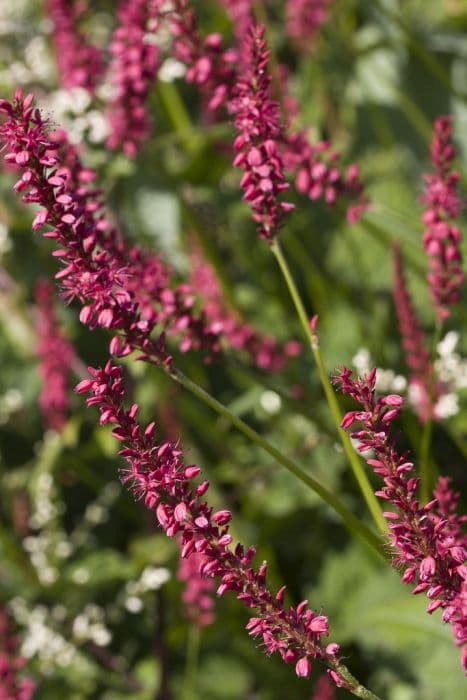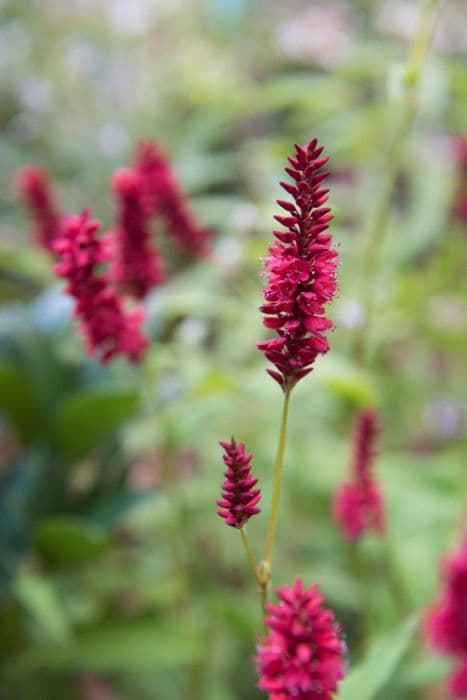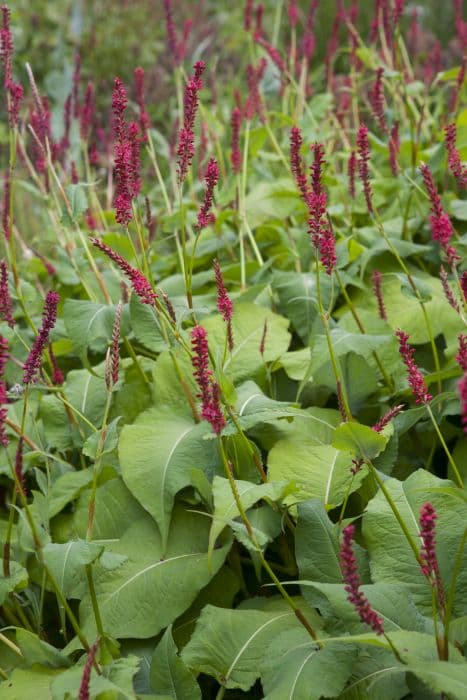Knotweed Persicaria 'Indian Summer'

ABOUT
The Indian Summer is a striking plant with a vibrant and colorful appearance. It sports a lush mound of dense foliage, characterized by elongated, lance-shaped leaves. The leaves themselves have a distinguished look, often showcasing a rich, dark green hue, and may sometimes bear a reddish or bronzy tint, adding to their visual interest. Throughout the blooming period, the Indian Summer becomes even more spectacular, as it produces slender spikes of tiny flowers that shoot up and hover above the foliage like delicate wands. These flowers are typically a deep pink or red color, forming a dense, brush-like cluster that adds a pop of intense color to gardens or landscapes. The warmth and intensity of the colors evoke the feeling of a late-summer sunset, which is likely the inspiration behind its evocative name. Overall, the Indian Summer presents a lush and vibrant display that can create an inviting and dynamic atmosphere in any planting arrangement.
About this plant
 Names
NamesSynonyms
Indian Summer Knotweed, Indian Summer Fleeceflower
Common names
Persicaria amplexicaulis 'Indian Summer'
 Toxicity
ToxicityTo humans
Persicaria 'Indian Summer' is generally not considered highly toxic to humans. However, like many plants, it may cause mild stomach upset if ingested in large quantities. Symptoms of ingestion could include nausea, vomiting, and diarrhea. It's always a good practice to avoid eating any part of ornamental plants due to potential adverse reactions or unknown levels of toxicity.
To pets
Persicaria 'Indian Summer' is also not widely recognized as a highly toxic plant to pets. However, pets with sensitive stomachs might experience mild gastrointestinal upset if they ingest parts of the plant. This could result in symptoms such as vomiting or diarrhea. It's advisable to keep an eye on pets around ornamental plants and to discourage them from eating plant material to avoid any potential issues.
 Characteristics
CharacteristicsLife cycle
Perennials
Foliage type
Deciduous
Color of leaves
Green
Flower color
Pink
Height
4 feet (1.22 meters)
Spread
2 feet (0.61 meters)
Plant type
Herb
Hardiness zones
5
Native area
Himalaya
Benefits
 General Benefits
General Benefits- Aesthetic Appeal: Persicaria 'Indian Summer' adds vibrant color and visual interest to gardens with its vivid pink flower spikes.
- Long Blooming Period: This plant blooms for an extended period from midsummer to fall, ensuring a colorful display for many months.
- Attracts Pollinators: The flowers attract a variety of pollinators such as bees and butterflies, promoting biodiversity.
- Low Maintenance: Once established, it requires minimal care, making it suitable for gardeners of all skill levels.
- Drought Tolerance: Persicaria 'Indian Summer' has good tolerance to dry conditions, reducing the need for frequent watering.
- Versatility: It can be used in borders, as a groundcover, or in containers, offering flexibility in garden design.
- Rapid Growth: It grows quickly and can fill in garden spaces, helping to suppress weeds.
- Seasonal Interest: With its changing foliage colors, 'Indian Summer' provides interest throughout the seasons, not just when in bloom.
 Medical Properties
Medical PropertiesThis plant is not used for medical purposes.
 Air-purifying Qualities
Air-purifying QualitiesThis plant is not specifically known for air purifying qualities.
 Other Uses
Other Uses- Persicaria 'Indian Summer' can be used as a natural dye for fabrics, imparting a range of colors from greens to browns depending on the mordant used.
- The leaves of the plant can be incorporated into decorative pressed flower crafts, such as bookmarks or framed art.
- Fresh or dried plant matter can be included in potpourri mixes for a subtle, earthy aroma.
- The stems can be woven or braided into rustic garden structures or supports for other climbing plants.
- You can use the flowers as a natural food coloring for desserts or pastries, providing a tinge of color and unique flavor.
- Its dense foliage can be used as a living mulch to keep soil temperature regulated and reduce weed growth.
- Dried Persicaria 'Indian Summer' can serve as a filler in bouquets and dried floral arrangements, adding texture and interest.
- When placed in a pond or water garden, this plant can provide an attractive habitat for aquatic wildlife, including frogs and insects.
- In a sensory garden, the varied textures and scents of the plant can provide an educational and therapeutic experience.
- Combine cuttings from Persicaria 'Indian Summer' with other garden greens and florals to construct a natural privacy screen for your outdoor space.
Interesting Facts
 Feng Shui
Feng ShuiThe plant Persicaria is not used in Feng Shui practice.
 Zodiac Sign Compitability
Zodiac Sign CompitabilityThe plant Persicaria is not used in astrology practice.
 Plant Symbolism
Plant Symbolism- Change and Transformation: Similar to many plants in its family, Persicaria 'Indian Summer' could symbolize change and transformation, represented by its seasonal color changes and robust growth patterns.
- Adaptability and Resilience: This plant can thrive in a variety of conditions, symbolizing adaptability and resilience in the face of challenges.
- Abundance and Prosperity: The lush foliage and profusion of blooms could represent abundance and prosperity, an ideal symbol for gardens that seek to emulate growth and fertility.
- Healing and Restoration: In some traditions, members of the Persicaria genus are used for their medicinal properties, so this plant may carry connotations of healing and restoring balance.
 Water
WaterThe Knotweed, commonly known as Persicaria 'Indian Summer', should be watered deeply to saturate the root zone and then allowed to dry out slightly before watering again. During active growth in the spring and summer, water approximately once per week, providing about 1-1.5 inches of water each time, which translates to about 0.623 gallons for an average-sized plant. During the fall and winter, reduce watering to every other week or less, depending on the plant's environment and the weather conditions. Always check the soil moisture before watering to avoid overwatering, which can lead to root rot.
 Light
LightThe Knotweed thrives best in full sun to partial shade. It should be placed in a location where it can receive at least four to six hours of sunlight daily. However, in hotter climates, some afternoon shade is beneficial to prevent scorching of the leaves.
 Temperature
TemperatureThe Knotweed prefers a temperature range between 50°F and 75°F, thriving best within this range. It can tolerate temperatures as low as 30°F but should be protected from frost. Extreme heat over 90°F can stress the plant, so provide some shade and additional watering during heatwaves.
 Pruning
PruningPruning the Knotweed is essential to maintain its shape and encourage bushier growth. Prune in early spring to remove any dead or damaged stems and to shape the plant. Additionally, deadheading or removing spent flowers can encourage further blooming. Severe pruning is generally not needed unless the plant has become overgrown, in which case it can be cut back by a third in late winter or early spring.
 Cleaning
CleaningAs needed
 Soil
SoilFor Persicaria, commonly known as Knotweed, a rich, moist, well-drained soil mixture is ideal. Incorporate organic matter like compost or well-rotted manure to enhance fertility. A slightly acidic to neutral soil pH, ranging from 6.0 to 7.0, is preferable for Persicaria 'Indian Summer'.
 Repotting
RepottingKnotweed, or Persicaria 'Indian Summer', should be repotted every two to three years to replenish the soil and accommodate its growth. It is best to repot in the spring before the new growth starts.
 Humidity & Misting
Humidity & MistingKnotweed, or Persicaria 'Indian Summer', thrives in average to high humidity levels. Mimicking its natural, damp habitat, maintaining a humidity level around 60-80% is often ideal for this plant.
 Suitable locations
Suitable locationsIndoor
Place in bright, indirect light and keep soil consistently moist.
Outdoor
Choose a sunny to part-shade spot and keep soil well-watered.
Hardiness zone
5-9 USDA
 Life cycle
Life cyclePersicaria 'Indian Summer', more commonly known as knotweed, begins its life cycle from seed germination, typically in spring, when soil temperatures and moisture levels are adequate. The seedlings establish roots and shoots, developing into young plants with characteristic lance-shaped leaves. Through the growing season, the plant vigorously develops a bushy structure, reaching mature size and producing clusters of small, densely-packed flowers, often in shades of pink or red, which attract pollinators. After flowering, which can last until the first frosts of late autumn, the plant sets seed, ensuring the continuation of the next generation. As winter sets in, the above-ground parts of the plant die back, while the roots or rhizomes may remain dormant through winter, ready to regrow when favorable conditions return. If the plant is perennial, the cycle repeats annually, with the same root system sending up new shoots each spring; if it's treated as an annual, new plants must grow from seed each year.
 Propogation
PropogationPropogation time
Spring-Early Summer
Propogation: Persicaria 'Indian Summer', commonly known as knotweed, is best propagated through division, which is the most popular method for this perennial plant. The ideal time to propagate through division is in the early spring or autumn when the plant is not actively growing. To propagate, carefully dig up the plant and gently separate the root ball into smaller sections, making sure each division has a good amount of roots and shoots. Replant the sections at the same depth they were growing at before and water them thoroughly to help establish the new plants. This straightforward method allows gardeners to quickly increase their stock of Persicaria 'Indian Summer' and is perfect for sharing with fellow plant enthusiasts.









